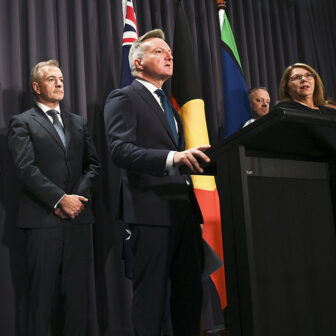On his way to Canberra airport recently, Rohan Greenland asked his cab driver to pull over. For anyone who knows Greenland — a public health advocate who likes to “walk the talk” — it will come as no surprise that he was squeezing in a chance for some exercise before his flight.
Greenland began his working life as a journalist at the Canberra Times before deciding it was “more exciting to help create the news rather than report it.” While working for ACT health minister Gary Humphries in the early 1990s, he began to develop an appreciation for public health.
“Neither of us knew much about health,” Greenland remembers. “We soon realised all the bad news came out of hospitals and all the good news stories came out of public health. Not only was it so important in terms of reducing disease, the media loved it.” Greenland went on to “fall in love” with public health as director of public affairs for the Australian Medical Association, working with high-profile AMA presidents including Brendan Nelson and Kerryn Phelps.
One way to understand what Greenland means by “public health” is to consider the career of one of the field’s heroes, the late Basil Hetzel, whose early advocacy is a textbook example of how to prevent health problems on a large scale. Hetzel’s research in Papua New Guinea in the 1960s showed that treating iodine deficiency could prevent a congenital syndrome characterised by severely stunted physical and mental growth, previously known as cretinism. Rather than simply encouraging individuals to take iodine supplements, he successfully argued that iodine should be added to salt across the globe.
Greenland, who is now a senior advocate with the National Heart Foundation of Australia, observes that the political environment has become tougher for public health advocates in recent years, partly because of competition from increasing numbers of health industry lobbyists. “The growth in companies that have paid lobbyists and advocates is making it a very crowded space,” he says.
The other big challenge has been a bipartisan enthusiasm for small government and big business, which has tended to treat health as an outcome of individual choices and behaviours. Governments, and especially Coalition governments, have neglected public health policies designed to tackle the underlying determinants of heath — including poverty, food and housing insecurity, and racism — and have inadequately regulated fossil fuels, tobacco, alcohol, junk foods and other harmful products.
These industries no doubt celebrated when the Abbott government axed the Australian National Preventive Health Agency, or ANPHA, in 2014. Barely three years old, ANPHA had been charged with assembling evidence, developing programs and generating momentum, particularly in relation to alcohol, tobacco and obesity, which are estimated to contribute to around 40 per cent of potentially preventable hospitalisations for chronic conditions. It had been hoped that ANPHA would counterbalance the “big-time, burly avarice that drives health-destroying profiteering,” as one of the luminaries of public health, Stephen Leeder wrote in 2014.
The Abbott government also scrapped the National Partnership Agreement on Preventive Health, under which federal funding had supported public health interventions and infrastructure in the states and territories since 2008. Research published in the Health Promotion Journal of Australia last December blamed the agreement’s demise for the cancellation of important chronic-disease-prevention programs, a reduction in the health-prevention workforce, and “a return to a situation where there is little coordination or clarity around the roles of the different levels of government with respect to chronic-disease prevention.”
Despite the absence of national leadership, the public health landscape has not been entirely bleak, with actions coming from other quarters. These include First 1000 Days Australia and Deadly Choices, initiatives led by Aboriginal and Torres Strait Islander people in support of holistic and culturally appropriate health promotion. Following many years of advocacy by Aboriginal health leaders, the NT government recently introduced a minimum floor price on alcohol.
Public health experts also recently celebrated the news that alcohol labelling will need to carry warnings about the risks of consumption during pregnancy, crediting WA health minister Roger Cook for driving the move. This decision followed seven years of “delay and obstruction” by the alcohol industry, according to the Foundation for Alcohol Research and Education, in a reminder of whose interests tend to dominate public health policy-making.
It’s no surprise, then, that when Greenland was preparing to deliver the Basil Hetzel Oration to the Public Health Association of Australia conference in Cairns recently, he didn’t hold back in castigating our “ad hoc, inadequate and piecemeal” approach to public health.
“Why is it that, when confronted with sound evidence, compelling research, and clear solutions, we are so often frustrated with the failure of politicians to turn that evidence into action?” he asked. “Why is it that our health system — a system that sprints into action when there is the merest hint of food contamination — so utterly fails when it comes to public health and the prevention of disease, especially chronic disease?”
He acknowledged the constraints faced by health ministers and bureaucrats, including multiple competing priorities, a “very large number of often aggressive lobbyists and advocates,” and the agendas of “the all-powerful colleagues in marginal seats.” But it’s time to draw a line in the sand, he urged, calling for the establishment of an independent, national public health agency that “can help bypass the political and bureaucratic inertia that so often impedes progress.”
Greenland also called for a new public health fund with a dedicated funding stream, in the vein of the Future Fund or the Medical Research Future Fund, to lift the proportion of total health spending on public health from around 1.5 per cent to at least 4 per cent. He suggests this funding should come from a combination of hypothecation of a proportion of the taxation on tobacco and alcohol, as well as wider alcohol taxation reform, and a new levy on sugary drinks.
These suggestions would normally struggle to find broad support across both major parties, but the looming federal election offers an opportunity to explore the potential of resurrecting ANPHA or a similar agency. After all, ANPHA is not completely dead and buried, as the bill to abolish it didn’t pass the Senate.
In the run-up to the federal election, the Public Health Association plans to advocate strongly for a national agency to drive public health action, according to chief executive Terry Slevin, although he says more work is needed to develop the best structure and model, and to refine the economic case for public health interventions. “We will be working hard to make sure that good thinking goes into developing this concept and we will advocate to both sides ahead of the election.”
Meanwhile, at a Royal Australian College of General Practitioners conference on the Gold Coast last Friday, the Greens leader Senator Richard Di Natale committed to supporting ANPHA’s re-establishment if there is a change of government.
But should the government simply revive ANPHA as it was in those three years before 2014? Since the agency was chopped, the public health sector has increasingly recognised the need to work more widely and effectively to tackle the factors undermining good health. ANPHA’s demise also highlighted the vulnerability of such agencies to changes of government and short-termism.
Lyn Roberts, who was a member of ANPHA’s advisory council and has spent twenty years advocating to health ministers on public health matters, says that ANPHA’s demise underlines the need for any new agency to have a different structure and governance, and be established with bipartisan support.
ANPHA was hamstrung, she says, by how it was set up — as a statutory body that reported to the federal health minister — which enabled a new government to pull the activities back into the department. Roberts says a new agency should have its own board and the independence and capacity to pursue long-term programs. She points to VicHealth’s ten-year Action Agenda for Health Promotion as an example of how long-term planning is possible with the right structure.
She adds that the health community needs to be discussing how to build wider political support for such an agency and to ensure it takes a wide-ranging view of prevention and health equity. “It’s a good debate for us to have again, and a really important one,” she says.
Michael Moore, who was chief executive of the Public Health Association when ANPHA was still running, agrees that the critical issue is ensuring a more independent structure, so that ANPHA’s successor is at arm’s length from government and reports directly to the parliament. “ANPHA was a creature of that time, and I think that a replacement could do much better,” he says, suggesting that the structure of Food Standards Australia New Zealand offers a useful model.
Such an agency should not fall under the health department, he stresses, because it should also provide advice on wider policy areas affecting health, such as planning and regional development. A focus on equity and the social determinants of health should be written into the founding legislation, he adds.
Fran Baum, Matthew Flinders distinguished professor of public health at Flinders University and a longstanding advocate for embedding health across portfolios and policies, would like to see the prime minister’s department leading this work, to ensure a whole-of-government consideration of health and wellbeing. The existing Primary Health Networks, or PHNs, should also be charged with explicitly addressing health equity and the social determinants of health, she adds.
Also advocating a cross-portfolio approach is Ben Harris-Roxas, director of the South Eastern Sydney Research Collaboration Hub at the University of New South Wales. Harris-Roxas, who has worked at the complex and contested interface between governments, sectors, services, programs and communities, says that some PHNs are already embracing public health and intersectoral work. He expects they could do much more if they were encouraged to join with other agencies in funding programs and services.
“If they had more flexibility in how they can allocate funds and can start to see more co-design, it would be more obvious what role they could play in this space,” he says. “I don’t think anyone in the PHN space has nailed intersectoral prevention. Their planning processes are pretty prescribed; they need to have their work plans approved [by the federal health department].”
Any ANPHA-style agency will need courage and vision to work across portfolios and policies, says Harris-Roxas. It will need to engage a wide range of organisations and professions, including the medical colleges, and develop their capacity for working in genuine partnerships. “The ability to work intersectorally for health and for prevention, it does need a distinct set of skills, like being fair dinkum about working in partnerships, and it’s not actually often seen as core business of the health sector or organisations, and not that many people are skilled at doing it,” he says.
Harris-Roxas doesn’t advocate screening all policies for their health impacts, but says there are some glaring examples of where this would be useful. The health effects of cashless welfare cards, for example, have not been properly evaluated and are often hidden from all but those directly affected.
Renewable energy policy is another area crying out for health impact assessments, he says. “If there was recognition of the health co-benefits of some of the proposals, it might have helped to strengthen the arguments and get a bit more sustained policy direction on renewables. In all these things, prevention may not be the driver but may enable us to tweak, adjust, and add value to policies that are happening anyway, in order to get a better health return.”
While the Australian Medical Association and others want to see a local version of the US Centers for Disease Control and Prevention, Harris-Roxas says we should instead look to Finland and its National Institute for Health and Welfare, which falls under the social affairs and health ministry. It is one of the leaders among national health institutes, he says, in taking an intersectoral approach to health.
Meanwhile, Paul Grogan, director of public policy and knowledge management at Cancer Council Australia, stresses the importance of “political courage and bipartisanship” in delivering public health action. A statutory agency devoted to collecting and publishing findings would certainly be welcome, he says, but “we already have strong evidence for a number of policy interventions, which are not being implemented, across all levels of government.”
He goes on: “Mass media anti-smoking and skin cancer prevention campaigns, a tax on alcohol based on how much alcohol is actually in the product, fixing anomalies in the Health Star Rating food labelling system — there is a long list of unfinished work for which the evidence is strong. If we’re going to start creating new agencies and collecting new evidence, let’s not bypass the things we already know will save hundreds of thousands of lives.”
Of course, this discussion may all be academic. It’s a safe bet that ANPHA won’t be resurrected if the Morrison government is returned, and one senior public health advocate thinks the odds of a Labor government creating such an agency are just fifty–fifty.
But the story of public health, as Basil Hetzel’s legacy reminds us, is one of determination, persistence and commitment. Terry Slevin likes to say that prevention is not a sprint, it’s a marathon. But the urgency of public health crises such as climate change and the tide of chronic diseases suggests a need to bring a sprinter’s timeframe to the marathon effort. •
This is part of a series of health policy articles for Inside Story by Croakey editors Melissa Sweet and Jennifer Doggett.




